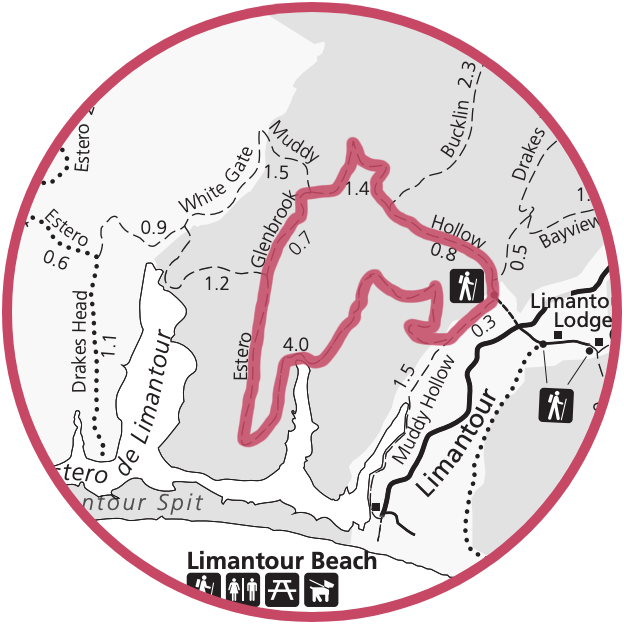Muddy Hollow Loop
Trail length: 7.3 miles
Terrain: coastal scrub
Restroom? No
Parking: gravel parking area
Kid friendly? Yes
Dates visited: 9/9/16, 8/18/19, 10/23/20
Favorite plants on this trail:
Loop: Muddy Hollow Road, Glenbrook, Estero
Hiking the loop in this order will put you facing the ocean on the Glenbrook and some of the Estero Trail. Starting at the Muddy Hollow Road trailhead, take the Muddy Hollow Road Trail 2.3 miles to Glenbrook Trail. (Be sure to take the correct Muddy Hollow trail — you want the one with “road” in the name. It starts where the gravel road ends, to the right of the parking area, and goes downhill and over a creek at its beginning.) Turn left onto Glenbrook and walk for 0.7 miles until the Estero Trail. Follow the Estero Trail for 4.0 miles to the Muddy Hollow Trail. Take a left and walk 0.3 miles on the Muddy Hollow Trail along the gravel road back to the parking area.
Start at the Muddy Hollow Trailhead
Take the Muddy Hollow Road Trail (on the right side of the parking area) 2.3 miles to Glenbrook Trail.
Turn left onto Glenbrook and walk for 0.7 miles where the trail becomes the Estero Trail.
Follow the Estero Trail for 4.0 miles to the Muddy Hollow Trail.
Take a left and walk 0.3 miles along the gravel road back to the parking area.
The Muddy Hollow Road Trail descends to a small creek which is not difficult to cross but I’ve slipped and stepped into the creek at least once resulting in a soggy hiking boot for the next few hours. The trail is mostly in the open with just a few trees arching over the trail for shade along the way. It tends to be cooler in this valley so heat is only an issue on very warm days in summer and fall. The views are expansive across the meadow and into the hills beyond. The Estero trail to the south (left) runs parallel to the Muddy Hollow Road trail for the first mile or so, but it’s hidden by a screen of trees.
The Glenbrook Trail is a connector between the Muddy Hollow Road Trail and the Estero Trail. It ascends gradually then flattens out with a beautiful view of the ocean in the distance. A few pine trees dot the path but the trail is primarily fully exposed to the sun and wind. You’re likely to see or hear Tule Elk in the distant hills and spot their antler rubbings and scraping marks on trees in the area.
This section of the Estero Trail (from Glenbrook to Muddy Hollow Trail) meanders across an open coastal scrub with views of the ocean and Drakes Bay. You’ll descend to a riparian area with willows and alders then into the bishop pine forest. This is a good trail for flowering plants including Paintbrushes, Orange Bush Monkeyflower (Mimulus aurantiacus), Pearly Everlasting (Anaphalis margaritacea), and the orchid Coast Piperia (Piperia elegans) in September, and many Pussy-Ears (Calochortus tolmiei) peeking out along the edges of the trail in late April. It's rich in California Mugwort (Artemisia douglasiana), Trailing Blackberry (Rubus ursinus), California Sagebrush (Artemisia californica), Coffeeberry (Frangula californica), and lupines. In winter, the trail is full of bright red mushrooms with white polka dots, Fly agaric.
Volunteer Opportunity: Audubon Canyon Ranch
Audubon Canyon Ranch is a non-profit environmental conservation and education organization. It was founded in 1962 to save a major heronry and block commercial development of Bolinas Lagoon in western Marin County, leading the way for the protection of Tomales Bay to the north, which now forms the eastern boundary of Point Reyes National Seashore. ACR has two research centers in West Marin: Cypress Grove Preserve in Marshall on the shores of Tomales Bay and Martin Griffin Preserve near the Bolinas Lagoon. Volunteers do bird monitoring in Tomales Bay, stewardship of Bolinas Lagoon, and educate school children as docents.



